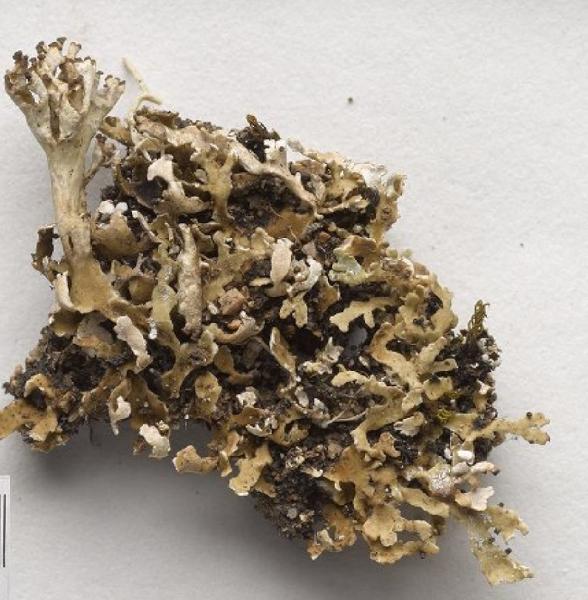Cladonia corsicana (Rondon & Vězda) Pino-Bodas, Burgaz & M.P. Martín
in Pino-Bodas & al., Mycol. Progr., 11, 1: 277, 2012. Basionym: Cladonia turgida var. corsicana Rondon & Vězda - in Vězda, Lich. Sel. Exs., 36: 2, no. 881, 1970
Synonyms:
Distribution: C- Sar (Pino-Bodas & al. 2012)
Description: Primary thallus squamulose, persistent, the squamules 6-14 mm long, 1-4 mm wide, erect, undivided or irregularly lobed, pale green in upper part, arachnoid and white to pale grey or pale pink beneath. Podetia frequent, cupless, branched at tips, hollow inside, 4-24 mm high, 2-10 mm wide, esorediate, entirely open and flattened, smoothly corticate, pale green, the podetial walls rarely twisted and joined at the base, often with oval perforations. Apothecia common, dark brown. Asci 8-spored, clavate, thickened at apex, with a K/I+ blue tholus and a K/I+ strongly blue outer gelatinous sheath, Cladonia-type. Ascospores 1-celled, hyaline, ellipsoid. Pycnidia on upper surface of squamules, more rarely on podetia, globose, with a colourless jelly. Conidia hyaline, curved. Photobiont chlorococcoid. Spot tests: K- or K+ yellowish slowly turning brown, C-, KC-, P+ red, UV-. Chemistry: fumarprotocetraric acid complex.Note: on acid soil and rock fissures, mostly in localities with dominant cork tree and in Cistus shrublands; described from Corsica and known also from Sardinia, Crete and the SW part of the Iberian Peninsula (Portugal, Spain).
Growth form: Fruticose
Substrata: soil, terricolous mosses, and plant debris
Photobiont: green algae other than Trentepohlia
Reproductive strategy: mainly sexual
Commonnes-rarity: (info)
Alpine belt: absent
Subalpine belt: absent
Oromediterranean belt: absent
Montane belt: absent
Submediterranean belt: very rare
Padanian area: absent
Humid submediterranean belt: very rare
Humid mediterranean belt: very rare
Dry mediterranean belt: very rare

Predictive model
Growth form: Fruticose
Substrata: soil, terricolous mosses, and plant debris
Photobiont: green algae other than Trentepohlia
Reproductive strategy: mainly sexual
Commonnes-rarity: (info)
Alpine belt: absent
Subalpine belt: absent
Oromediterranean belt: absent
Montane belt: absent
Submediterranean belt: very rare
Padanian area: absent
Humid submediterranean belt: very rare
Humid mediterranean belt: very rare
Dry mediterranean belt: very rare

Predictive model
 INDEX FUNGORUM
INDEX FUNGORUM
 GBIF
GBIF


